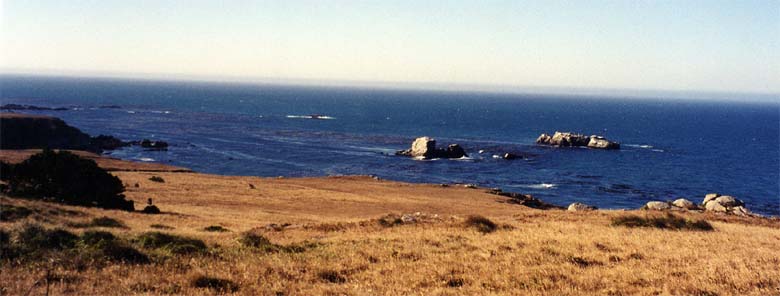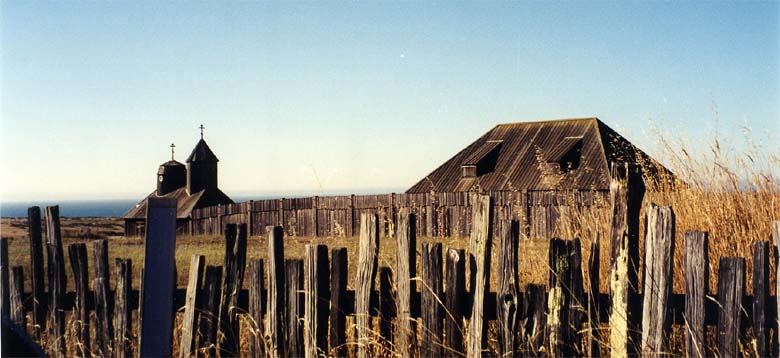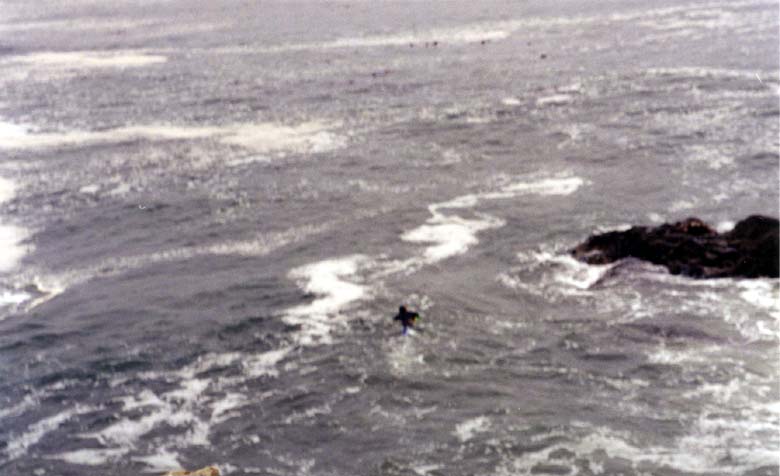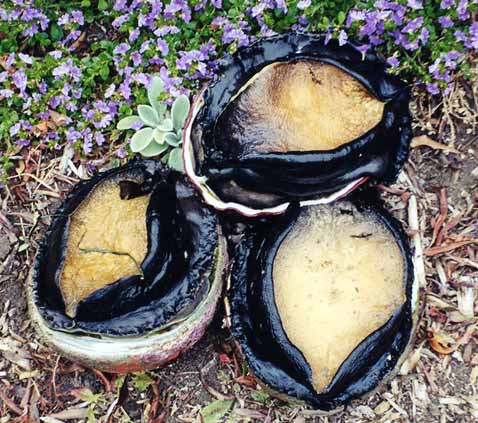Sometimes a dive trip is far more than a dive. Because of the extraordinary
natural beauty above water, that is often the case when diving the California
North Coast. As such, this story of a dive seems to start upon exiting
Hiway 101 at River Road in Santa Rosa.
We stopped at the vegetable stand and stocked up before continuing through
the farms and vineyards basking in the clear warm sunshine. As the hills
of the valley start to came together it cools. The oaks turn to redwoods and
the road gets closer to the Russian River as its calm summer persona meanders
towards the coast.
Then, it's time to stop at the beautiful flower gardens and redwood
groves of the Korbel Winery for lunch and a bit of sampling before buying
wine and champagne for our stay. This especially means their excellent
Le Premier Champagne that they only sell at the winery itself.
The road continues on in what is now a tight river valley between steep
coastal mountains. It winds through various small towns and resorts,
going through dimly lit groves of huge redwoods and then back into the
bright sunlight of flower filled river meadows.
After a short time, you come to the end of the river at Jenner and get
the first look at the conditions that will determine everything about
your diving. Hopefully, the waves coming into the river mouth are at
least as near as tranquil as all the sea lions sunning on the river
bank. Today, it was a bit rougher than that.

We then headed north up the turns and switchbacks of the hill that gave this road the name of the 'Dramamine Hiway'. It just gets more beautiful as you continue. On your left, cliffs tower above the rocky shore. On the right are fields of grass giving into redwood covered mountains that go on as far as you can see. Looking behind you from the mountainside, Bodega Head is usually visible past miles of wild shore line. If it is a clear day without the usual traces of fog, you may even see Point Reyes.

As the road progresses down the hill, you pass various weathered ranches.
Looking off shore is to see what is obviously lush reef areas. Every mile
traveled is a mile past excellent diving, if there is a way to get to it
below the coastal cliffs.
Most of the road from here on is along coastal bluffs past fields with
Eucalyptus, Oak, Pine and rows of huge old Cypress trees. Anytime the
road turns inland to a canyon, it changes from bright sunlight to the
dimness of a thick redwood forest.
The road goes past the well known dive spots of Salt Point, Fort Ross and
the Gerstle Cove Reserve.

It was overcast as we finally got to Sea Ranch and got situated. Even though
it was late, I wanted to go diving, because the swell map predicted that it
would be picking up a lot by the next evening. I got things together and went
looking for a dive.
The north part of Sea Ranch doesn't have that many abalone, but the ones
you do find tend to be fairly big. 9 to 9 1/2 inches are not uncommon so
there is always the incentive that you might find a 10 incher and that's
pretty good.
Since we were staying at Soundings, the shore was only about 120 feet from
my door. Just walk the deer trail through the ferns and dried grasses to
the coastal bluff trail. Then it's a matter of walking to a likely looking
entry site. Since this closest area is an ecological reserve, you have to
walk down a bit and anyway, it is all cliffs and while they are not more
than 30 feet high, there is no way to get to the beach. I walked south until
I passed the reserve boundary and then on to what looked like a possible
entry.
For me, this is diving back at my roots. Walk along a new rocky shore and
look for somewhere to get into the water.
The first likely place I found was a not much of a trail, but someone had
tied an old rope to a bush for help getting down the top 10 feet of the
cliff that was an almost vertical rock. Below that were very big boulders
that could be negotiated to the water.
The first part of a dive like this is to learn the lay of the land and (water)to
get the feel for the dive site. This was especially true for this site,
because though it looked divable, it also clearly looked like a place
unforgiving of mistakes.

Offshore about 35 feet we two large barrier rocks paralleling the shore with about a 40 foot slot between them. The waves were big enough to go over them and then create a rip current as the water went back out through the slot between them.

Past the slot, was a large area with strands of Bull Kelp, that looked
like good abalone hunting area. It was a tough enough area to get through,
that I hoped it would be lightly visited if I went a ways off shore.
Emergency bailout was to the south. Though there was some swell, it looked
like there was little long shore current, just that interesting rip through
the slot.
Deb stayed on the top of the bluff as
I went down the rope with all my extra gear in my backpack/innertube float.
Many of the boulders were sharp and 8 to 10 feet high and so hard to get past.
There was an entry between them about 15 feet to the side of the slot where
the rocks went right to the water. It was fairly calm since the offshore
rocks pretty much blocked it. I climbed up over the boulders to another
entry that was right in front of the slot and observed from there. It was
a bit rough. What looked like the best plan was to go in at the first entry
and exit from the entry right in front of the slot. So I climbed back to
the first entry and geared up. The entry was easy and I was able to ride
the rip current through the slot. It was just about 6 p.m. right
then.

I continued off shore until I was clear and looked back. I hadn't realized how narrow my planned exit area was. It was an opening perhaps 2 feet wide between large straight faced boulders that had some serious waves breaking on them. Well, that was to worry about later. I swam to the outside of the bull kelps, perhaps 100 yards off shore. The lack of wave action suggested it was fairly deep. It seemed like a good place to start out considering that I had not done much serious free diving in the year since I had last been here. As expected, my first few dives were not too good and though I was seeing the rocks at about 25 feet, that was not the bottom. After a few dives, I figured it was time to get serious. I got a lot of air and did a high legged surface dive. Visibility was OK, but at this hour, things are just dim. There were large boulders with thick growth and a strong surge. To look for abalone, you mostly have to get to the bottom of the cracks between them. After a couple of dives I got into a crack that ended at some rocks and under one, I saw my first abalone of the season and it was a fairly big one. I had no trouble with my iron and popped it off before leisurely swimming to the surface.

When I measured it at my float, it was just 9 inches. Nice start.
Even though I got the one, after that I decided that I should move in a
bit. At about 35 feet to the bottom of the outer rocks, it seemed a bit
deep for the abs. Also, the light was dim enough that it got to be hard to
see things while moving in the surge. Encounters were of the near and fast
kind.
It was relaxing to be free diving,
but it was deep and rough enough to be a bit demanding. In the deeper water,
it was a matter of diving along the outside of the rocks that plunge down
to the sand. Inside the reef, it is a matter of going down to the bottom
of the cracks between the rocks and moving through the thick lamanarias
growing on the bottom. It is best to be as low as possible so that you can
be looking up under boulders. All these vertical rock walls are not the best
habitat for abalone. They like flat spots.
I made more dives in about 25 feet of water and while I was seeing a lot
of different invertebrates, I was not seeing abs. I saw something a bit
into a crack and touched it with my ab iron before I figured out that it
was a big urchin. That says that recognition distance for stuff in cracks
was less than 2 feet. Still, out in the open it was bright enough and I was
seeing lots of giant anemones, urchins and tunicates. I found two abs, but
both were in cracks between tight rocks. Neither were easily reachable
and I wasn't sure of their size either.
I was making a lot of dives and had to make a lot of calculations. It was
late and seemed to be getting just a bit rougher. I really wanted to get
2 more abalone to fill out my limit, but wasn't seeing any and I still had
to negotiate the slot in. There were no immediate problems. I wasn't cold
or tired, so I just kept diving. Then I saw a ledge sticking up at a steep
angle about 4 feet from the bottom with boulders a couple feet off of it.
There was a nice sized abalone at the end. I popped it off and looked on.
About 2 feet away was another abalone, but not so big. 6 feet past that
though was another nice big one. I got it and headed for the surface. When
I got there I held both of them over my head to show Deb before I put them
in the float.
Now it was time to get in again. Deb and I had agreed on hand signals so
that she could signal me when the set was big... as if I couldn't see for
myself that it had grown some. I swam to the outside of the slot to wait
and she kept signaling me off. Since the waves were occasionally breaking at
the start of the slot, going in there was making a commitment. She finally
signaled me to move in and away I went, straight into a fair rip. I was
swimming hard but only slowly, if steadily, making progress. I really didn't
think it would matter much. The chances were that before I could swim across
the rip to shore, some waves would come through the slot to help me. Then I
just had to make sure where I hit. I had to be sure I didn't get pushed
along the shore any, away from the narrow exit. Sure enough some waves
came along and pushed me straight to shore over the rip. Then it was a
matter of swimming and riding into the space between the boulders. Since
the exit turned right behind a boulder right away, I was immediately in a
shallow protected pool. At least protected from the big waves if not a lot
of splash.
Unfortunately, I had left my flops by where I had entered and the sharp
rocks made it a hard climb back to there. After that, going up the cliff
was easy enough. Deb said that it had picked up some in size, but the
biggest change that the sets had started getting closer and closer together
such that there was almost no break between them.
As I walked back along the cliff, looking at the sun lowering over the
cypress trees, I was exhilarated. There is nothing that wakes one up, body
and soul, like a good swim in the ocean.

Enjoy the diving, seahunt